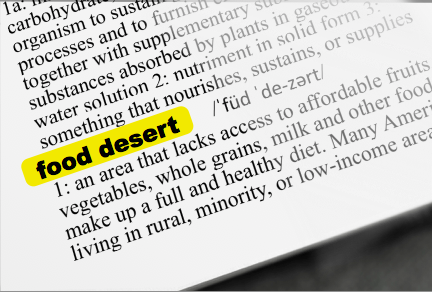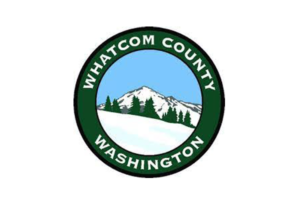What is a food desert?
The CDC characterizes a food desert as an area lacking in affordable fruits and vegetables, often found in rural, minority or low-income areas where access to healthy foods are limited (CDC 2011).
In recent years, the term has been used to characterize a number of scenarios: a community’s low access to supermarkets, low access to fresh foods, an over-abundance of access to cheap fast food options (sometimes referred to as a “food swamp” – where the only food available within walking distance are products high in sugar, fat, and salt), and others.
Who is at risk?
The US Department of Health and Human Services notes that food deserts exist in rural, urban, and tribal communities. However, rural and urban food deserts are defined differently. An urban food desert is characterized by having low access to a supermarket or healthy food retail options within a mile of your home; in a rural food desert, those options are more than 10 miles away. This acknowledges the difference in infrastructure and population density that occurs in these two scenarios in addition to the varying access to transportation that occurs in each environment.
The term “food desert” arrived on the national stage in 2009 with Michelle Obama’s creation of the White House Task Force on Childhood Obesity. The First Lady launched a number of food and diet related health programs during that first term in office, one of which included the Healthy Food Financing Initiative, a program dedicated to bringing healthy food retailers to underserved rural and urban communities across the US. The initiative came out of a 2009 USDA study linking obesity and diet related diseases to the distance a family has to travel to a supermarket, their ability to access transportation, and the prevalence of other retail options and income-related factors. The study reported that 5.8 million Americans live at least half a mile from a supermarket and are without access to a vehicle; moreover, 23.5 million people who live in low-income areas are more than a mile from a supermarket. In addition, obesity and food access disproportionately affect people of color, with Hispanic Americans being 1.2 times more likely to be obese than non-Hispanic whites, and Hispanic children being 1.8 times more likely to be obese (OMH, 2015).
What the term Food Desert is missing…
Since 2009, the term Food Desert has seen widespread use to describe communities that are characterized by an overall lack of healthy food options and a dearth of health in general. The term became more controversial as these issues were further investigated and defined – especially by the communities directly affected by this issue.
Food access advocates and food justice organizations have drilled down into the metrics that determine a food desert, bringing more nuance and concrete data to the term. Policy Map, a fantastic GIS mapping tool by the Reinvestment Fund, provides data layers and census tracts on “Low Supermarket Access Areas” in addition to a data layer on “Food Deserts.” The Low Supermarket Access (LSA) area metric takes into account not only distance to a supermarket, but car ownership, census tract data, income, AND the availability of supermarket retail options. The term LSA is preferable to food desert because it incorporates other contributing factors that play into how and why people buy and eat certain food products — as opposed to one demographic factor such as income or geography. But even a metric like “LSA” cannot factor in SNAP enrollment or nutrition/cooking education availability – two resources that impact the type of food an individual may buy and whether or not they know how to cook healthy foods at home.
In addition to the actual metrics surrounding how a Food Desert is defined, there’s also this issue of the term desert. When we think of a desert, we think of a barren wasteland, devoid of water and people. So how do communities feel about being described as a wasteland devoid of life? Not great, and many food justice activists make this point, arguing that their communities are filled with vibrant, culturally fecund, and dynamic members — all very much ALIVE, despite their low access to healthy food, state of poverty, or lack of transportation. A “desert” is no way to describe a “living” place.
What work is happening to address this issue? Healthy Corner Stores and Mobile markets
Our work at New Venture Advisors has seen many communities and organizations working hard to address the prevalence of food deserts in their cities. Ideas like The Food Trust’s Healthy Corner Store Initiative works to get fresh fruits and vegetables into existing food retail outlets by addressing the issue of consumer demand in these areas. (It is estimated that in order to open a supermarket, demand in the area must warrant $14 million in sales per year, a number that is often too high for low-income residents to meet). This provides access to healthy food in the stores where people are already used to shopping. Another trend is the growth of mobile food markets. While a big-box supermarket or farmer’s market may not open in your neighborhood for a variety of reasons, there is value in bringing healthy food TO the community to meet people where they are, without them having to obtain transportation or adjust their purchasing patterns. Mobile markets often accept SNAP or WIC benefits and offer a variety of fresh fruits and vegetables in a different location throughout the week.
We are encouraged by the countless innovative solutions happening in communities we work in all over the US to address the underlying issues that create Food Deserts through food access, food security, and food justice initiatives. Each project takes into account numerous variables, as no two communities or cities are identical in their demographics, challenges, or resources — New Venture Advisors has seen first hand that there is no one-size-fits-all approach when it comes to tackling the tough issues our food system faces, but we are so excited by all the ideas and the communities that have been strengthened by taking the first step towards a better, more equitable food system for all.



